An Analysis of IKEA's Corporate Strategy and Governance Performance
VerifiedAdded on 2023/02/02
|37
|8676
|79
Report
AI Summary
This report provides a comprehensive analysis of IKEA's corporate strategy and governance, exploring its impact on organizational performance. The study begins with an introduction to IKEA and its global operations, followed by an examination of the research problem, aims, objectives, and questions. A literature review covers key concepts such as corporate strategy, corporate governance, the MESA model, and the business strategic transformational model. The research methodology is then outlined, detailing the research onion, philosophy, approach, design, data sources, and analysis techniques. The report includes a critical review of the findings, incorporating SMART objectives and a GANTT chart, and concludes with recommendations and an action plan for improving IKEA's corporate strategy and governance. Appendices provide supplementary information, including the MESA model and the Anglo-Saxon model.
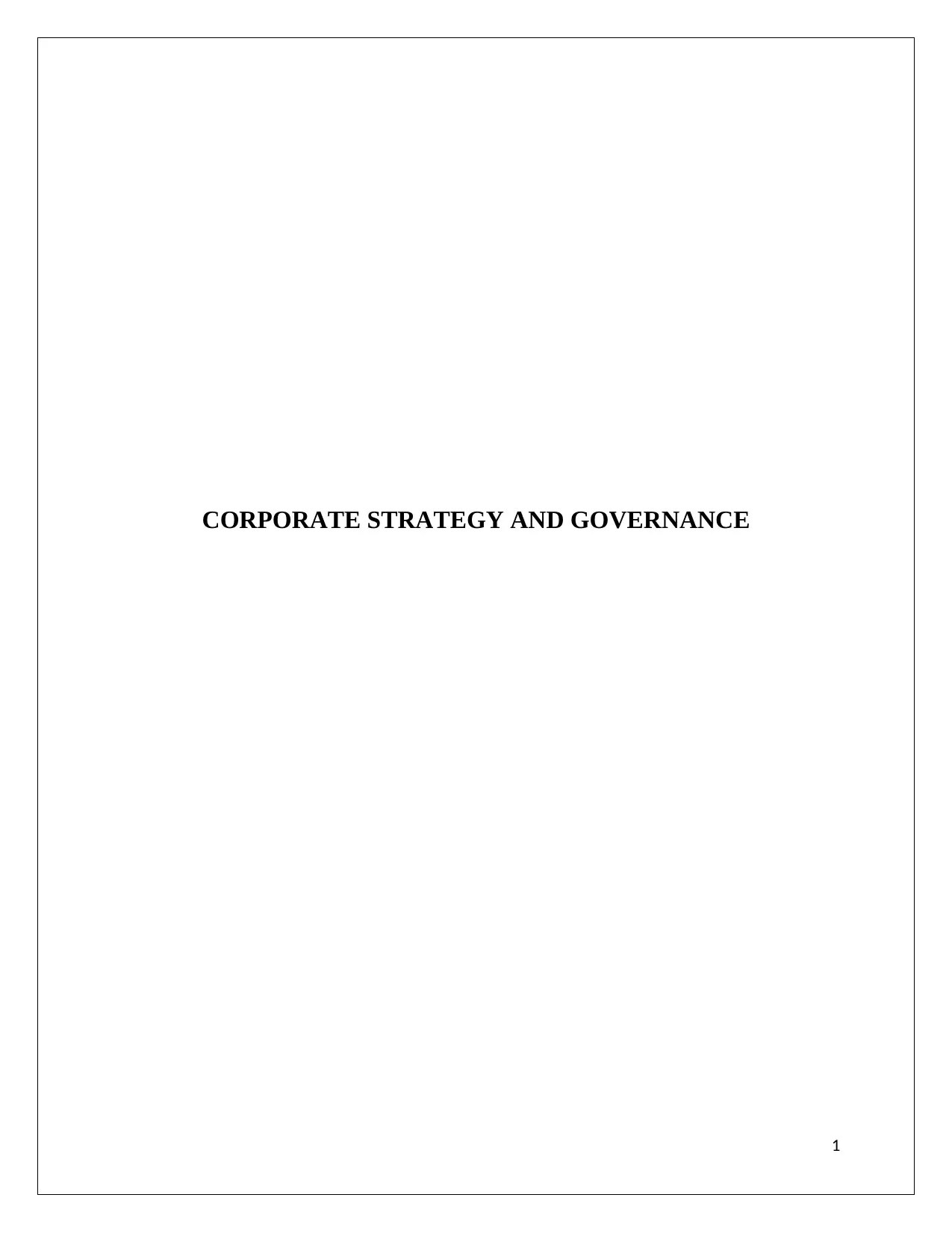
CORPORATE STRATEGY AND GOVERNANCE
1
1
Paraphrase This Document
Need a fresh take? Get an instant paraphrase of this document with our AI Paraphraser
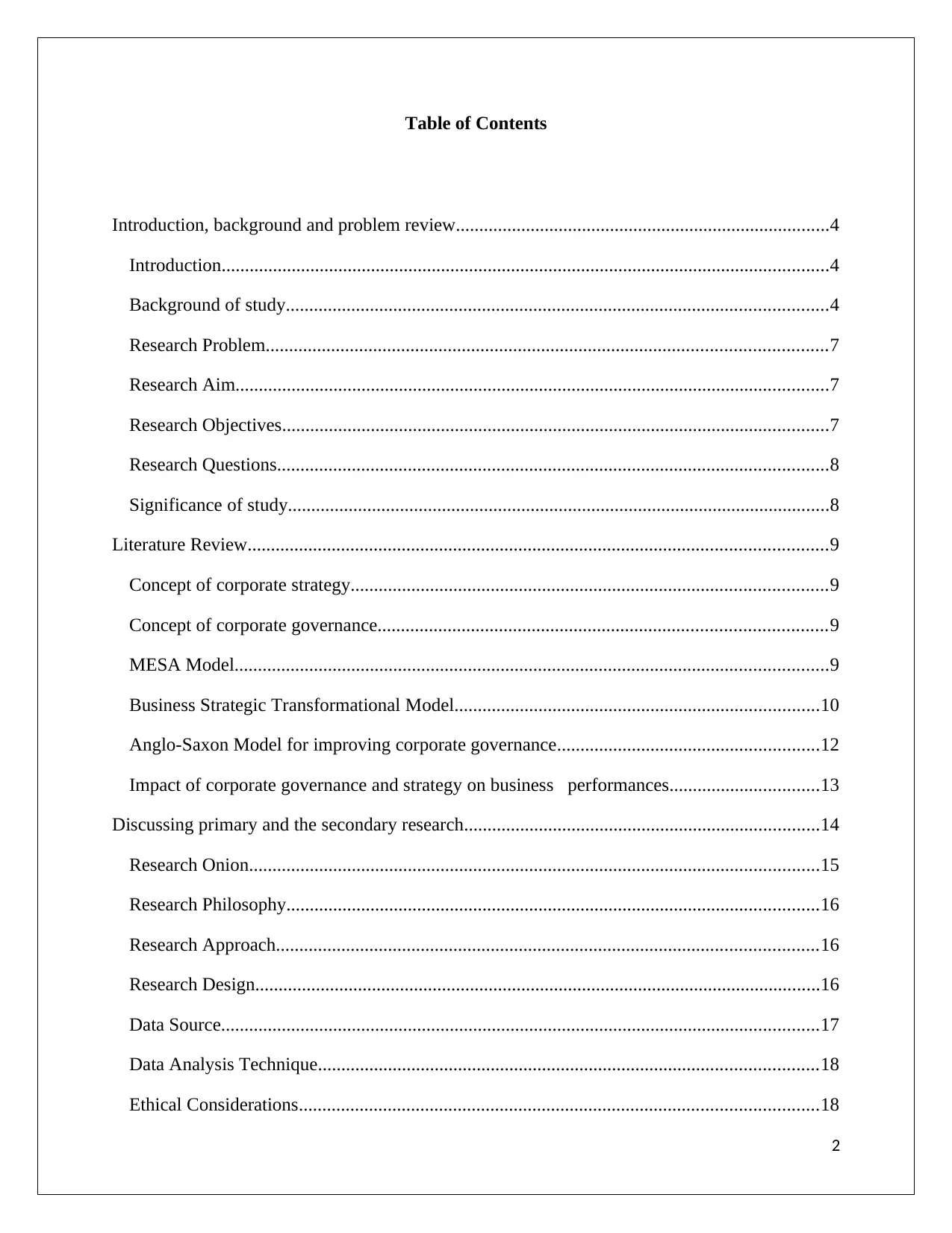
Table of Contents
Introduction, background and problem review................................................................................4
Introduction..................................................................................................................................4
Background of study....................................................................................................................4
Research Problem........................................................................................................................7
Research Aim...............................................................................................................................7
Research Objectives.....................................................................................................................7
Research Questions......................................................................................................................8
Significance of study....................................................................................................................8
Literature Review............................................................................................................................9
Concept of corporate strategy......................................................................................................9
Concept of corporate governance................................................................................................9
MESA Model...............................................................................................................................9
Business Strategic Transformational Model..............................................................................10
Anglo-Saxon Model for improving corporate governance........................................................12
Impact of corporate governance and strategy on business performances................................13
Discussing primary and the secondary research............................................................................14
Research Onion..........................................................................................................................15
Research Philosophy..................................................................................................................16
Research Approach....................................................................................................................16
Research Design.........................................................................................................................16
Data Source................................................................................................................................17
Data Analysis Technique...........................................................................................................18
Ethical Considerations...............................................................................................................18
2
Introduction, background and problem review................................................................................4
Introduction..................................................................................................................................4
Background of study....................................................................................................................4
Research Problem........................................................................................................................7
Research Aim...............................................................................................................................7
Research Objectives.....................................................................................................................7
Research Questions......................................................................................................................8
Significance of study....................................................................................................................8
Literature Review............................................................................................................................9
Concept of corporate strategy......................................................................................................9
Concept of corporate governance................................................................................................9
MESA Model...............................................................................................................................9
Business Strategic Transformational Model..............................................................................10
Anglo-Saxon Model for improving corporate governance........................................................12
Impact of corporate governance and strategy on business performances................................13
Discussing primary and the secondary research............................................................................14
Research Onion..........................................................................................................................15
Research Philosophy..................................................................................................................16
Research Approach....................................................................................................................16
Research Design.........................................................................................................................16
Data Source................................................................................................................................17
Data Analysis Technique...........................................................................................................18
Ethical Considerations...............................................................................................................18
2
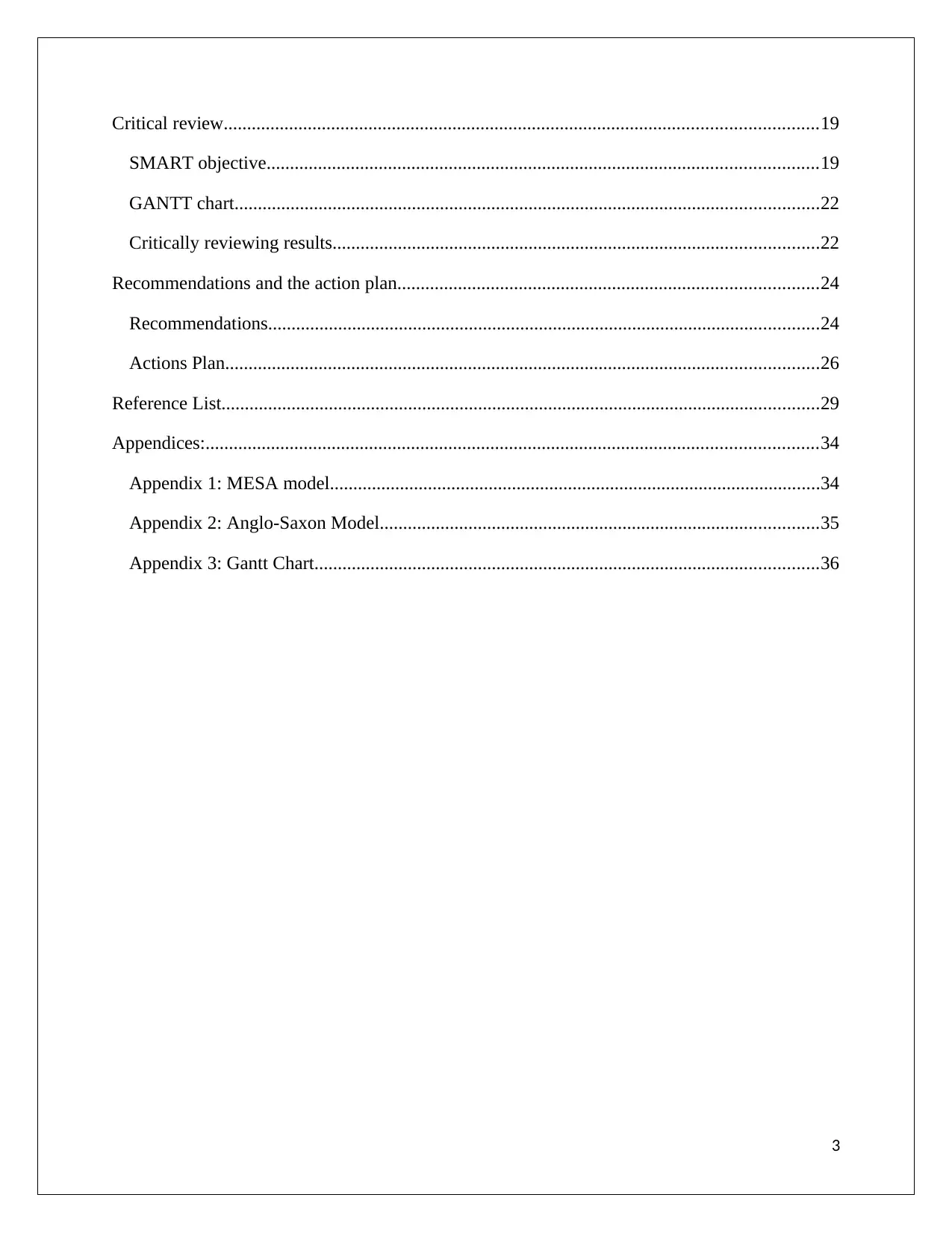
Critical review...............................................................................................................................19
SMART objective......................................................................................................................19
GANTT chart.............................................................................................................................22
Critically reviewing results........................................................................................................22
Recommendations and the action plan..........................................................................................24
Recommendations......................................................................................................................24
Actions Plan...............................................................................................................................26
Reference List................................................................................................................................29
Appendices:...................................................................................................................................34
Appendix 1: MESA model.........................................................................................................34
Appendix 2: Anglo-Saxon Model..............................................................................................35
Appendix 3: Gantt Chart............................................................................................................36
3
SMART objective......................................................................................................................19
GANTT chart.............................................................................................................................22
Critically reviewing results........................................................................................................22
Recommendations and the action plan..........................................................................................24
Recommendations......................................................................................................................24
Actions Plan...............................................................................................................................26
Reference List................................................................................................................................29
Appendices:...................................................................................................................................34
Appendix 1: MESA model.........................................................................................................34
Appendix 2: Anglo-Saxon Model..............................................................................................35
Appendix 3: Gantt Chart............................................................................................................36
3
⊘ This is a preview!⊘
Do you want full access?
Subscribe today to unlock all pages.

Trusted by 1+ million students worldwide
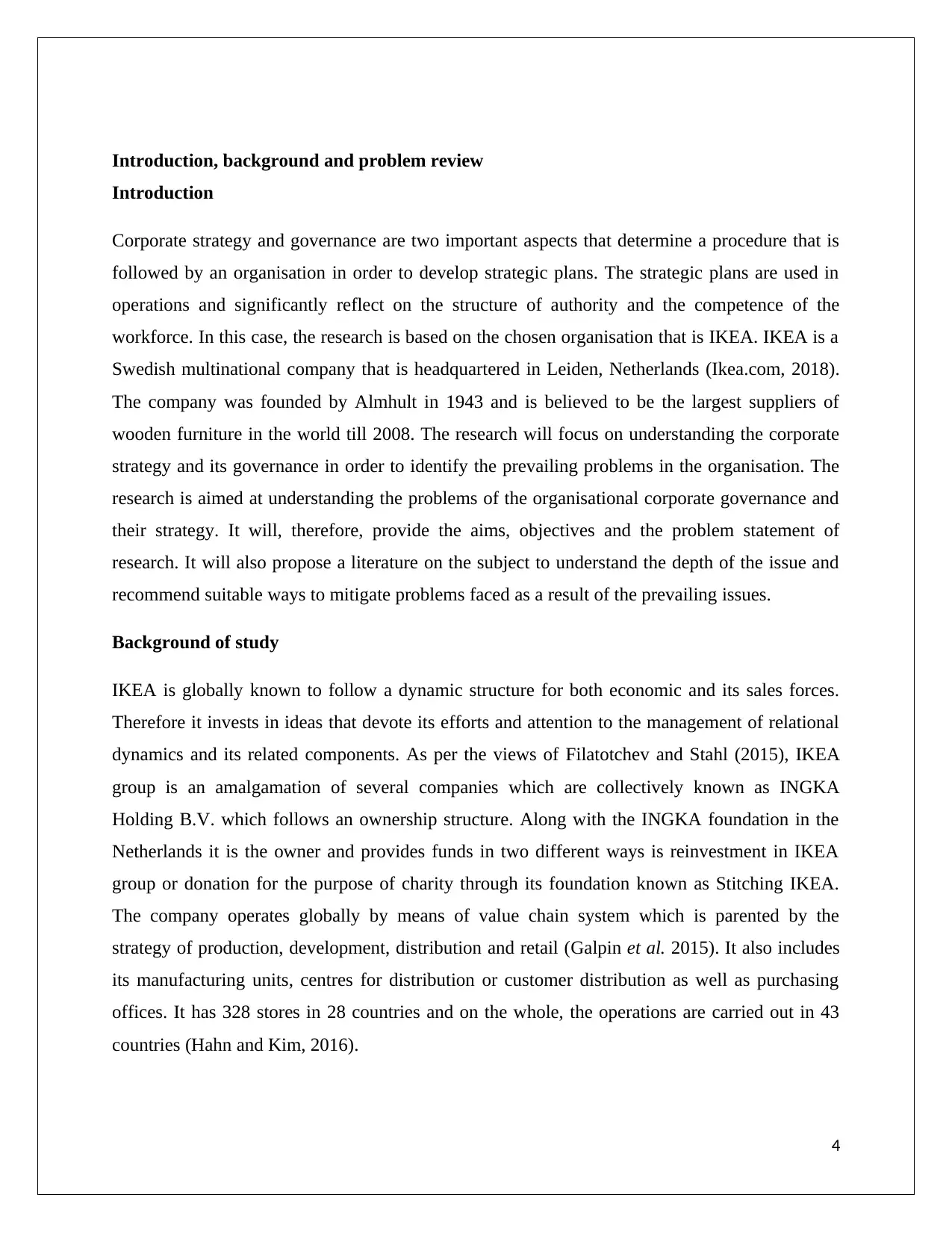
Introduction, background and problem review
Introduction
Corporate strategy and governance are two important aspects that determine a procedure that is
followed by an organisation in order to develop strategic plans. The strategic plans are used in
operations and significantly reflect on the structure of authority and the competence of the
workforce. In this case, the research is based on the chosen organisation that is IKEA. IKEA is a
Swedish multinational company that is headquartered in Leiden, Netherlands (Ikea.com, 2018).
The company was founded by Almhult in 1943 and is believed to be the largest suppliers of
wooden furniture in the world till 2008. The research will focus on understanding the corporate
strategy and its governance in order to identify the prevailing problems in the organisation. The
research is aimed at understanding the problems of the organisational corporate governance and
their strategy. It will, therefore, provide the aims, objectives and the problem statement of
research. It will also propose a literature on the subject to understand the depth of the issue and
recommend suitable ways to mitigate problems faced as a result of the prevailing issues.
Background of study
IKEA is globally known to follow a dynamic structure for both economic and its sales forces.
Therefore it invests in ideas that devote its efforts and attention to the management of relational
dynamics and its related components. As per the views of Filatotchev and Stahl (2015), IKEA
group is an amalgamation of several companies which are collectively known as INGKA
Holding B.V. which follows an ownership structure. Along with the INGKA foundation in the
Netherlands it is the owner and provides funds in two different ways is reinvestment in IKEA
group or donation for the purpose of charity through its foundation known as Stitching IKEA.
The company operates globally by means of value chain system which is parented by the
strategy of production, development, distribution and retail (Galpin et al. 2015). It also includes
its manufacturing units, centres for distribution or customer distribution as well as purchasing
offices. It has 328 stores in 28 countries and on the whole, the operations are carried out in 43
countries (Hahn and Kim, 2016).
4
Introduction
Corporate strategy and governance are two important aspects that determine a procedure that is
followed by an organisation in order to develop strategic plans. The strategic plans are used in
operations and significantly reflect on the structure of authority and the competence of the
workforce. In this case, the research is based on the chosen organisation that is IKEA. IKEA is a
Swedish multinational company that is headquartered in Leiden, Netherlands (Ikea.com, 2018).
The company was founded by Almhult in 1943 and is believed to be the largest suppliers of
wooden furniture in the world till 2008. The research will focus on understanding the corporate
strategy and its governance in order to identify the prevailing problems in the organisation. The
research is aimed at understanding the problems of the organisational corporate governance and
their strategy. It will, therefore, provide the aims, objectives and the problem statement of
research. It will also propose a literature on the subject to understand the depth of the issue and
recommend suitable ways to mitigate problems faced as a result of the prevailing issues.
Background of study
IKEA is globally known to follow a dynamic structure for both economic and its sales forces.
Therefore it invests in ideas that devote its efforts and attention to the management of relational
dynamics and its related components. As per the views of Filatotchev and Stahl (2015), IKEA
group is an amalgamation of several companies which are collectively known as INGKA
Holding B.V. which follows an ownership structure. Along with the INGKA foundation in the
Netherlands it is the owner and provides funds in two different ways is reinvestment in IKEA
group or donation for the purpose of charity through its foundation known as Stitching IKEA.
The company operates globally by means of value chain system which is parented by the
strategy of production, development, distribution and retail (Galpin et al. 2015). It also includes
its manufacturing units, centres for distribution or customer distribution as well as purchasing
offices. It has 328 stores in 28 countries and on the whole, the operations are carried out in 43
countries (Hahn and Kim, 2016).
4
Paraphrase This Document
Need a fresh take? Get an instant paraphrase of this document with our AI Paraphraser
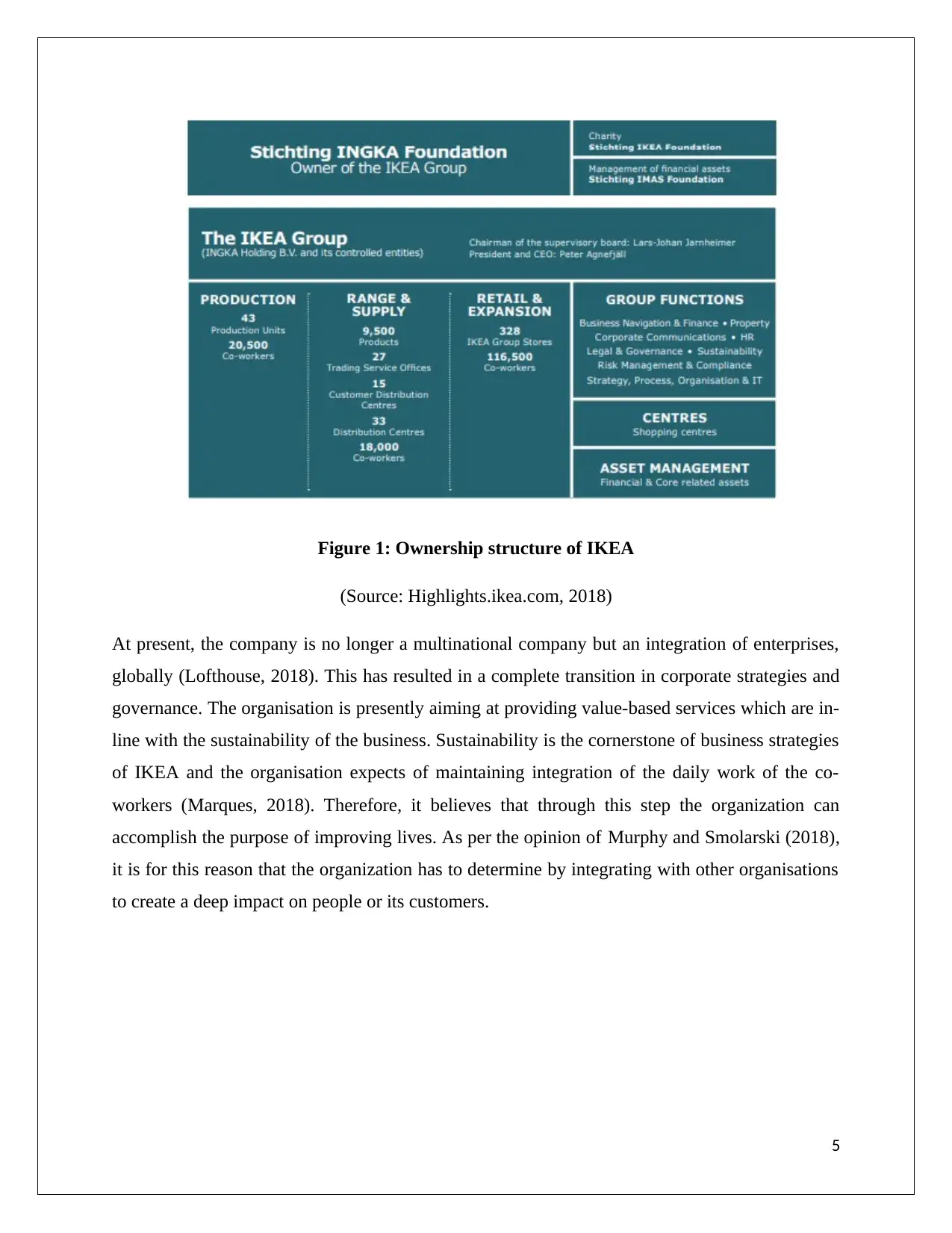
Figure 1: Ownership structure of IKEA
(Source: Highlights.ikea.com, 2018)
At present, the company is no longer a multinational company but an integration of enterprises,
globally (Lofthouse, 2018). This has resulted in a complete transition in corporate strategies and
governance. The organisation is presently aiming at providing value-based services which are in-
line with the sustainability of the business. Sustainability is the cornerstone of business strategies
of IKEA and the organisation expects of maintaining integration of the daily work of the co-
workers (Marques, 2018). Therefore, it believes that through this step the organization can
accomplish the purpose of improving lives. As per the opinion of Murphy and Smolarski (2018),
it is for this reason that the organization has to determine by integrating with other organisations
to create a deep impact on people or its customers.
5
(Source: Highlights.ikea.com, 2018)
At present, the company is no longer a multinational company but an integration of enterprises,
globally (Lofthouse, 2018). This has resulted in a complete transition in corporate strategies and
governance. The organisation is presently aiming at providing value-based services which are in-
line with the sustainability of the business. Sustainability is the cornerstone of business strategies
of IKEA and the organisation expects of maintaining integration of the daily work of the co-
workers (Marques, 2018). Therefore, it believes that through this step the organization can
accomplish the purpose of improving lives. As per the opinion of Murphy and Smolarski (2018),
it is for this reason that the organization has to determine by integrating with other organisations
to create a deep impact on people or its customers.
5
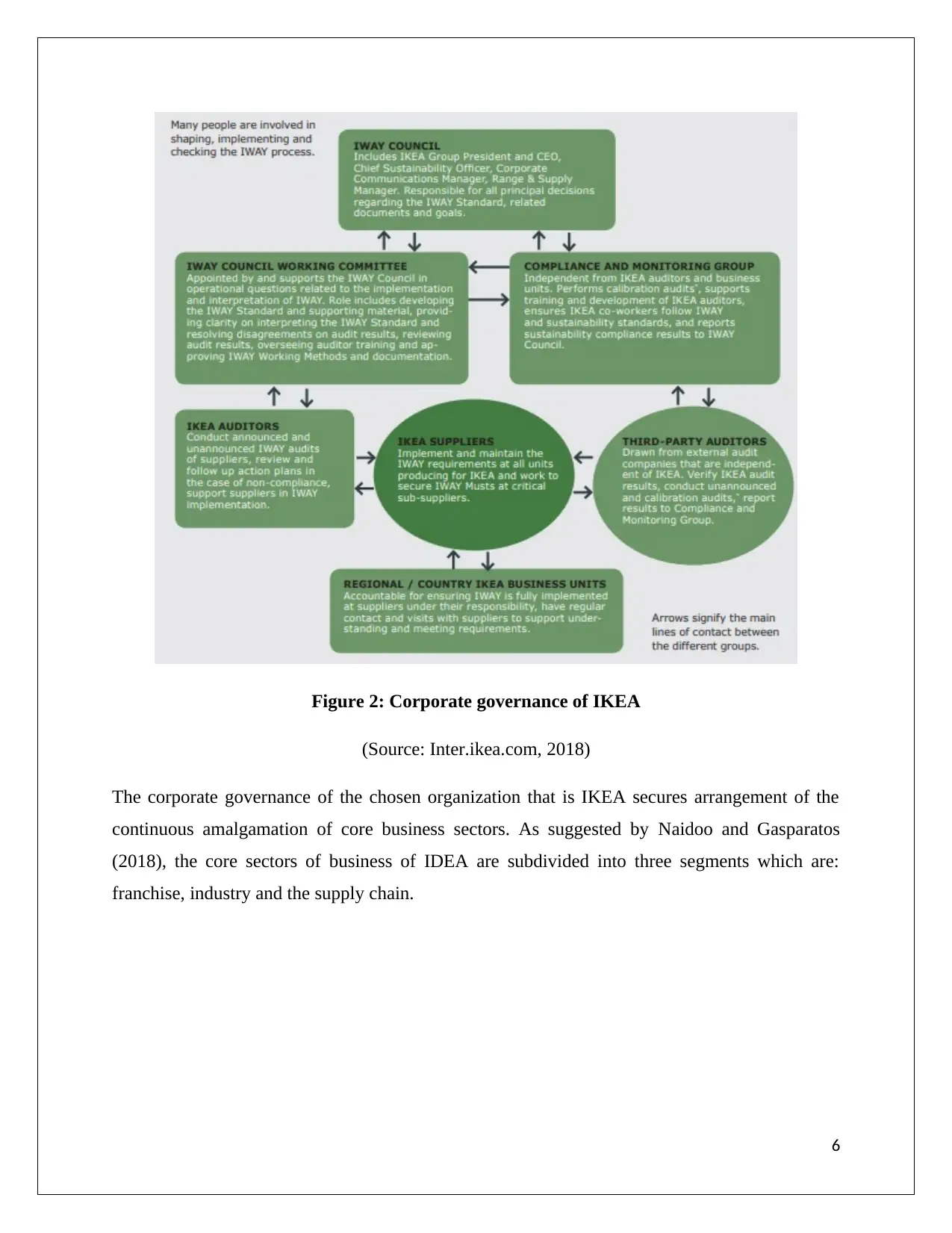
Figure 2: Corporate governance of IKEA
(Source: Inter.ikea.com, 2018)
The corporate governance of the chosen organization that is IKEA secures arrangement of the
continuous amalgamation of core business sectors. As suggested by Naidoo and Gasparatos
(2018), the core sectors of business of IDEA are subdivided into three segments which are:
franchise, industry and the supply chain.
6
(Source: Inter.ikea.com, 2018)
The corporate governance of the chosen organization that is IKEA secures arrangement of the
continuous amalgamation of core business sectors. As suggested by Naidoo and Gasparatos
(2018), the core sectors of business of IDEA are subdivided into three segments which are:
franchise, industry and the supply chain.
6
⊘ This is a preview!⊘
Do you want full access?
Subscribe today to unlock all pages.

Trusted by 1+ million students worldwide
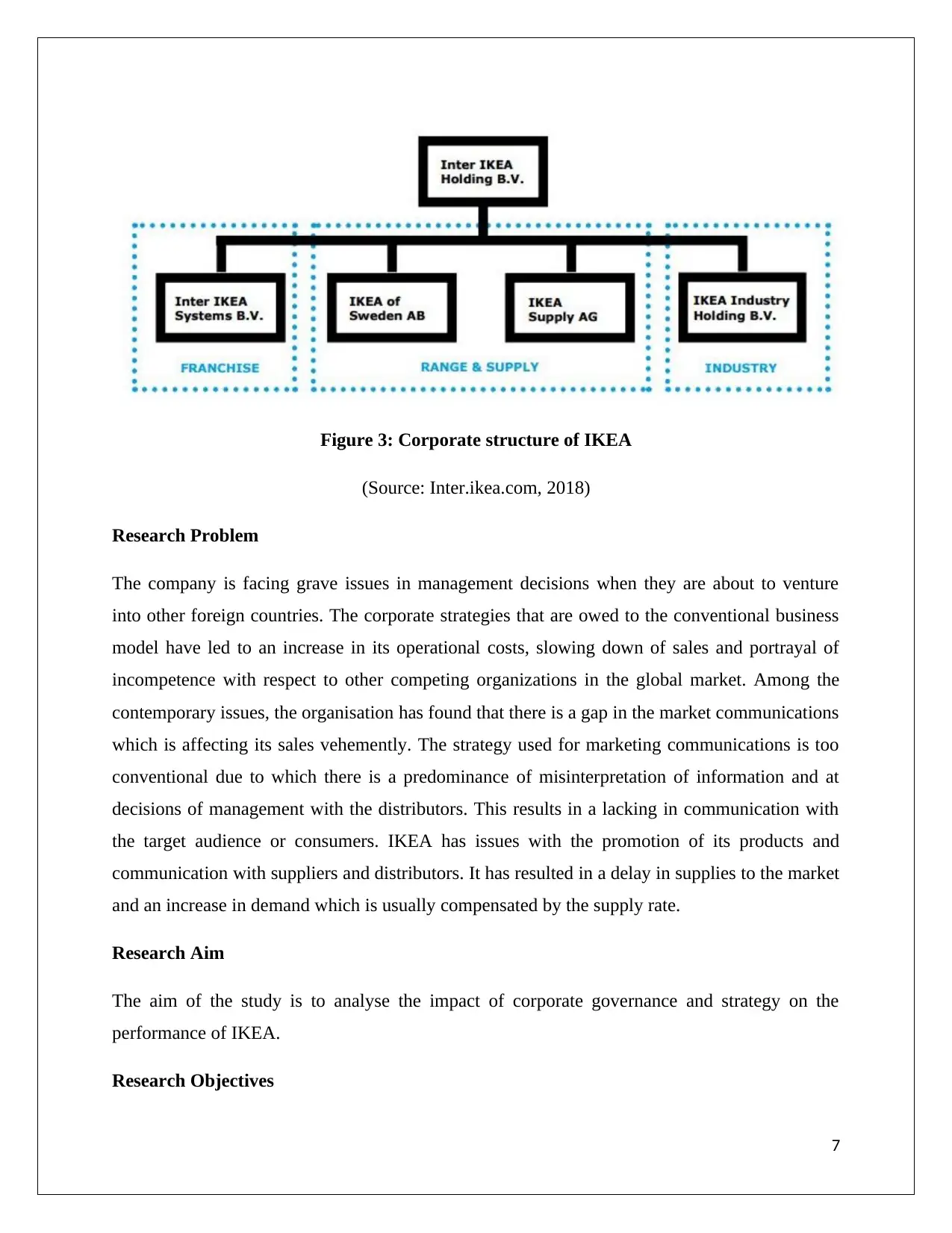
Figure 3: Corporate structure of IKEA
(Source: Inter.ikea.com, 2018)
Research Problem
The company is facing grave issues in management decisions when they are about to venture
into other foreign countries. The corporate strategies that are owed to the conventional business
model have led to an increase in its operational costs, slowing down of sales and portrayal of
incompetence with respect to other competing organizations in the global market. Among the
contemporary issues, the organisation has found that there is a gap in the market communications
which is affecting its sales vehemently. The strategy used for marketing communications is too
conventional due to which there is a predominance of misinterpretation of information and at
decisions of management with the distributors. This results in a lacking in communication with
the target audience or consumers. IKEA has issues with the promotion of its products and
communication with suppliers and distributors. It has resulted in a delay in supplies to the market
and an increase in demand which is usually compensated by the supply rate.
Research Aim
The aim of the study is to analyse the impact of corporate governance and strategy on the
performance of IKEA.
Research Objectives
7
(Source: Inter.ikea.com, 2018)
Research Problem
The company is facing grave issues in management decisions when they are about to venture
into other foreign countries. The corporate strategies that are owed to the conventional business
model have led to an increase in its operational costs, slowing down of sales and portrayal of
incompetence with respect to other competing organizations in the global market. Among the
contemporary issues, the organisation has found that there is a gap in the market communications
which is affecting its sales vehemently. The strategy used for marketing communications is too
conventional due to which there is a predominance of misinterpretation of information and at
decisions of management with the distributors. This results in a lacking in communication with
the target audience or consumers. IKEA has issues with the promotion of its products and
communication with suppliers and distributors. It has resulted in a delay in supplies to the market
and an increase in demand which is usually compensated by the supply rate.
Research Aim
The aim of the study is to analyse the impact of corporate governance and strategy on the
performance of IKEA.
Research Objectives
7
Paraphrase This Document
Need a fresh take? Get an instant paraphrase of this document with our AI Paraphraser
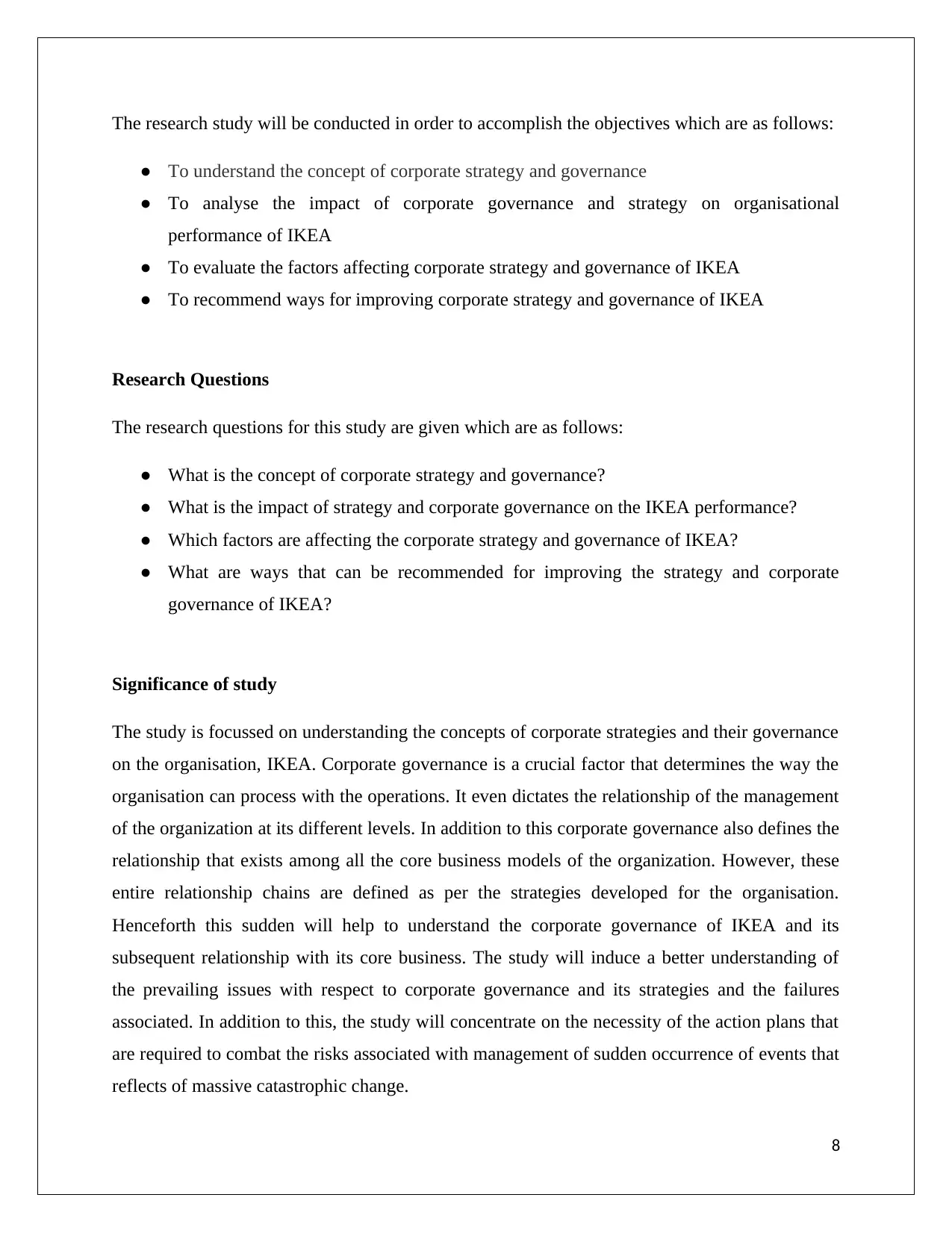
The research study will be conducted in order to accomplish the objectives which are as follows:
● To understand the concept of corporate strategy and governance
● To analyse the impact of corporate governance and strategy on organisational
performance of IKEA
● To evaluate the factors affecting corporate strategy and governance of IKEA
● To recommend ways for improving corporate strategy and governance of IKEA
Research Questions
The research questions for this study are given which are as follows:
● What is the concept of corporate strategy and governance?
● What is the impact of strategy and corporate governance on the IKEA performance?
● Which factors are affecting the corporate strategy and governance of IKEA?
● What are ways that can be recommended for improving the strategy and corporate
governance of IKEA?
Significance of study
The study is focussed on understanding the concepts of corporate strategies and their governance
on the organisation, IKEA. Corporate governance is a crucial factor that determines the way the
organisation can process with the operations. It even dictates the relationship of the management
of the organization at its different levels. In addition to this corporate governance also defines the
relationship that exists among all the core business models of the organization. However, these
entire relationship chains are defined as per the strategies developed for the organisation.
Henceforth this sudden will help to understand the corporate governance of IKEA and its
subsequent relationship with its core business. The study will induce a better understanding of
the prevailing issues with respect to corporate governance and its strategies and the failures
associated. In addition to this, the study will concentrate on the necessity of the action plans that
are required to combat the risks associated with management of sudden occurrence of events that
reflects of massive catastrophic change.
8
● To understand the concept of corporate strategy and governance
● To analyse the impact of corporate governance and strategy on organisational
performance of IKEA
● To evaluate the factors affecting corporate strategy and governance of IKEA
● To recommend ways for improving corporate strategy and governance of IKEA
Research Questions
The research questions for this study are given which are as follows:
● What is the concept of corporate strategy and governance?
● What is the impact of strategy and corporate governance on the IKEA performance?
● Which factors are affecting the corporate strategy and governance of IKEA?
● What are ways that can be recommended for improving the strategy and corporate
governance of IKEA?
Significance of study
The study is focussed on understanding the concepts of corporate strategies and their governance
on the organisation, IKEA. Corporate governance is a crucial factor that determines the way the
organisation can process with the operations. It even dictates the relationship of the management
of the organization at its different levels. In addition to this corporate governance also defines the
relationship that exists among all the core business models of the organization. However, these
entire relationship chains are defined as per the strategies developed for the organisation.
Henceforth this sudden will help to understand the corporate governance of IKEA and its
subsequent relationship with its core business. The study will induce a better understanding of
the prevailing issues with respect to corporate governance and its strategies and the failures
associated. In addition to this, the study will concentrate on the necessity of the action plans that
are required to combat the risks associated with management of sudden occurrence of events that
reflects of massive catastrophic change.
8
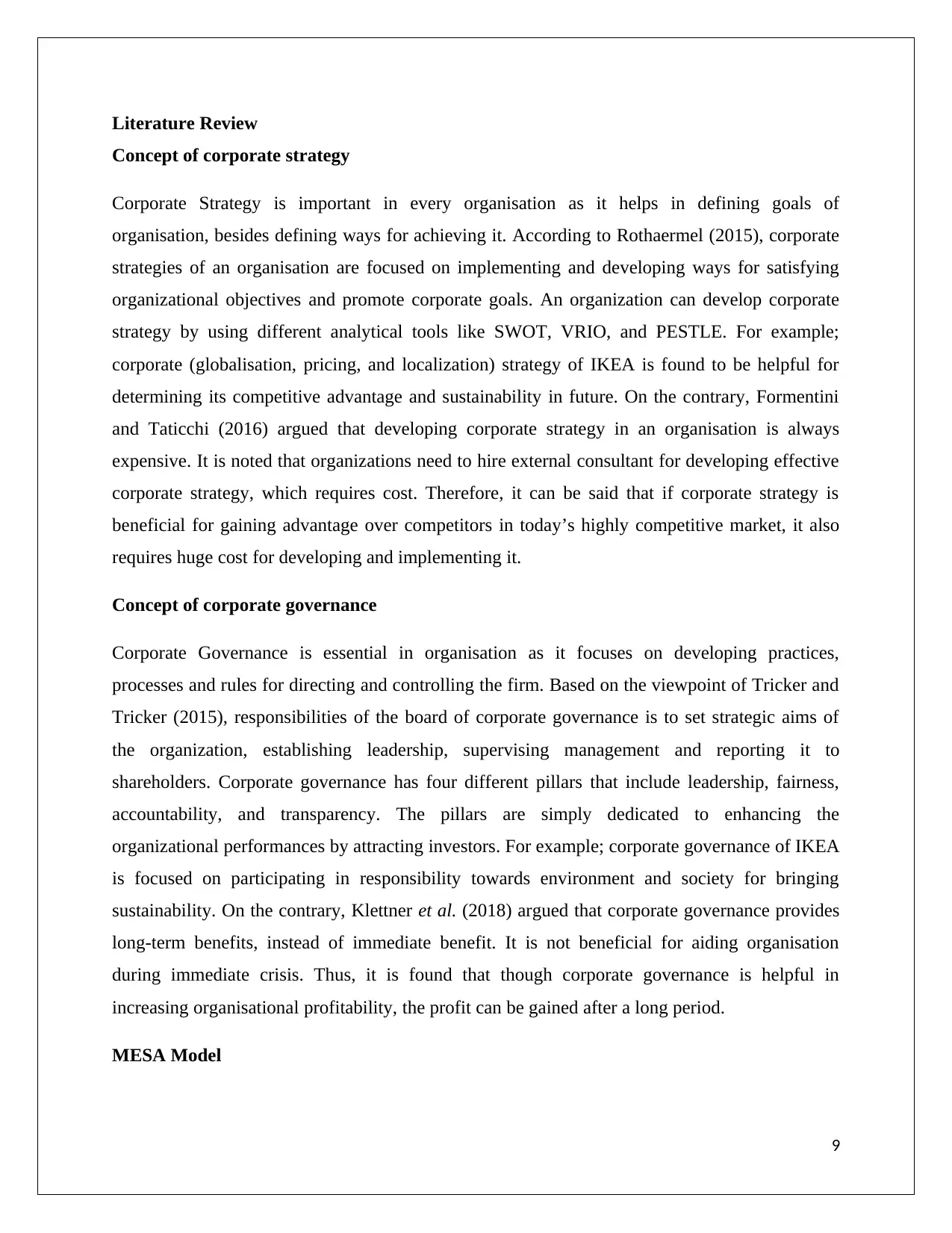
Literature Review
Concept of corporate strategy
Corporate Strategy is important in every organisation as it helps in defining goals of
organisation, besides defining ways for achieving it. According to Rothaermel (2015), corporate
strategies of an organisation are focused on implementing and developing ways for satisfying
organizational objectives and promote corporate goals. An organization can develop corporate
strategy by using different analytical tools like SWOT, VRIO, and PESTLE. For example;
corporate (globalisation, pricing, and localization) strategy of IKEA is found to be helpful for
determining its competitive advantage and sustainability in future. On the contrary, Formentini
and Taticchi (2016) argued that developing corporate strategy in an organisation is always
expensive. It is noted that organizations need to hire external consultant for developing effective
corporate strategy, which requires cost. Therefore, it can be said that if corporate strategy is
beneficial for gaining advantage over competitors in today’s highly competitive market, it also
requires huge cost for developing and implementing it.
Concept of corporate governance
Corporate Governance is essential in organisation as it focuses on developing practices,
processes and rules for directing and controlling the firm. Based on the viewpoint of Tricker and
Tricker (2015), responsibilities of the board of corporate governance is to set strategic aims of
the organization, establishing leadership, supervising management and reporting it to
shareholders. Corporate governance has four different pillars that include leadership, fairness,
accountability, and transparency. The pillars are simply dedicated to enhancing the
organizational performances by attracting investors. For example; corporate governance of IKEA
is focused on participating in responsibility towards environment and society for bringing
sustainability. On the contrary, Klettner et al. (2018) argued that corporate governance provides
long-term benefits, instead of immediate benefit. It is not beneficial for aiding organisation
during immediate crisis. Thus, it is found that though corporate governance is helpful in
increasing organisational profitability, the profit can be gained after a long period.
MESA Model
9
Concept of corporate strategy
Corporate Strategy is important in every organisation as it helps in defining goals of
organisation, besides defining ways for achieving it. According to Rothaermel (2015), corporate
strategies of an organisation are focused on implementing and developing ways for satisfying
organizational objectives and promote corporate goals. An organization can develop corporate
strategy by using different analytical tools like SWOT, VRIO, and PESTLE. For example;
corporate (globalisation, pricing, and localization) strategy of IKEA is found to be helpful for
determining its competitive advantage and sustainability in future. On the contrary, Formentini
and Taticchi (2016) argued that developing corporate strategy in an organisation is always
expensive. It is noted that organizations need to hire external consultant for developing effective
corporate strategy, which requires cost. Therefore, it can be said that if corporate strategy is
beneficial for gaining advantage over competitors in today’s highly competitive market, it also
requires huge cost for developing and implementing it.
Concept of corporate governance
Corporate Governance is essential in organisation as it focuses on developing practices,
processes and rules for directing and controlling the firm. Based on the viewpoint of Tricker and
Tricker (2015), responsibilities of the board of corporate governance is to set strategic aims of
the organization, establishing leadership, supervising management and reporting it to
shareholders. Corporate governance has four different pillars that include leadership, fairness,
accountability, and transparency. The pillars are simply dedicated to enhancing the
organizational performances by attracting investors. For example; corporate governance of IKEA
is focused on participating in responsibility towards environment and society for bringing
sustainability. On the contrary, Klettner et al. (2018) argued that corporate governance provides
long-term benefits, instead of immediate benefit. It is not beneficial for aiding organisation
during immediate crisis. Thus, it is found that though corporate governance is helpful in
increasing organisational profitability, the profit can be gained after a long period.
MESA Model
9
⊘ This is a preview!⊘
Do you want full access?
Subscribe today to unlock all pages.

Trusted by 1+ million students worldwide
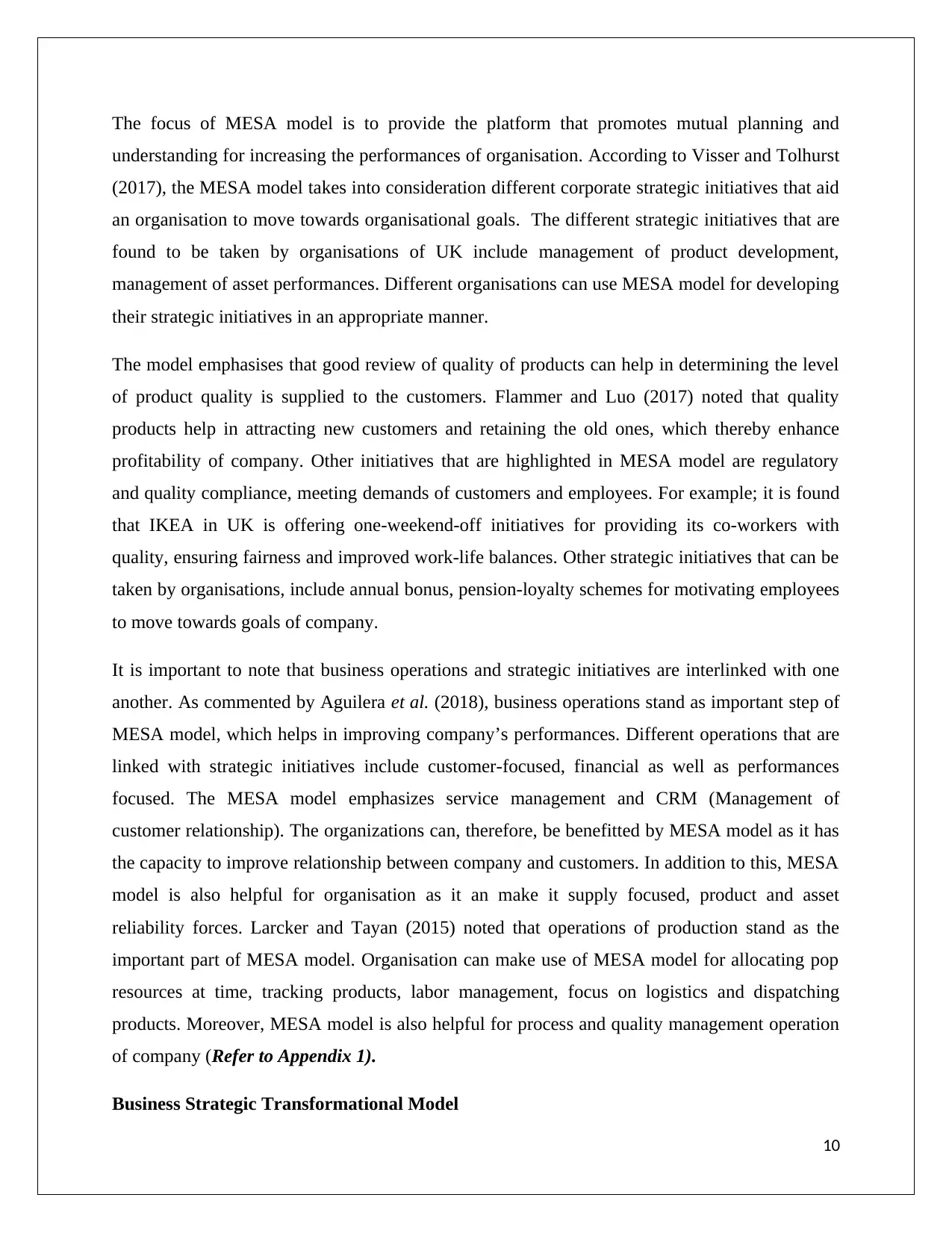
The focus of MESA model is to provide the platform that promotes mutual planning and
understanding for increasing the performances of organisation. According to Visser and Tolhurst
(2017), the MESA model takes into consideration different corporate strategic initiatives that aid
an organisation to move towards organisational goals. The different strategic initiatives that are
found to be taken by organisations of UK include management of product development,
management of asset performances. Different organisations can use MESA model for developing
their strategic initiatives in an appropriate manner.
The model emphasises that good review of quality of products can help in determining the level
of product quality is supplied to the customers. Flammer and Luo (2017) noted that quality
products help in attracting new customers and retaining the old ones, which thereby enhance
profitability of company. Other initiatives that are highlighted in MESA model are regulatory
and quality compliance, meeting demands of customers and employees. For example; it is found
that IKEA in UK is offering one-weekend-off initiatives for providing its co-workers with
quality, ensuring fairness and improved work-life balances. Other strategic initiatives that can be
taken by organisations, include annual bonus, pension-loyalty schemes for motivating employees
to move towards goals of company.
It is important to note that business operations and strategic initiatives are interlinked with one
another. As commented by Aguilera et al. (2018), business operations stand as important step of
MESA model, which helps in improving company’s performances. Different operations that are
linked with strategic initiatives include customer-focused, financial as well as performances
focused. The MESA model emphasizes service management and CRM (Management of
customer relationship). The organizations can, therefore, be benefitted by MESA model as it has
the capacity to improve relationship between company and customers. In addition to this, MESA
model is also helpful for organisation as it an make it supply focused, product and asset
reliability forces. Larcker and Tayan (2015) noted that operations of production stand as the
important part of MESA model. Organisation can make use of MESA model for allocating pop
resources at time, tracking products, labor management, focus on logistics and dispatching
products. Moreover, MESA model is also helpful for process and quality management operation
of company (Refer to Appendix 1).
Business Strategic Transformational Model
10
understanding for increasing the performances of organisation. According to Visser and Tolhurst
(2017), the MESA model takes into consideration different corporate strategic initiatives that aid
an organisation to move towards organisational goals. The different strategic initiatives that are
found to be taken by organisations of UK include management of product development,
management of asset performances. Different organisations can use MESA model for developing
their strategic initiatives in an appropriate manner.
The model emphasises that good review of quality of products can help in determining the level
of product quality is supplied to the customers. Flammer and Luo (2017) noted that quality
products help in attracting new customers and retaining the old ones, which thereby enhance
profitability of company. Other initiatives that are highlighted in MESA model are regulatory
and quality compliance, meeting demands of customers and employees. For example; it is found
that IKEA in UK is offering one-weekend-off initiatives for providing its co-workers with
quality, ensuring fairness and improved work-life balances. Other strategic initiatives that can be
taken by organisations, include annual bonus, pension-loyalty schemes for motivating employees
to move towards goals of company.
It is important to note that business operations and strategic initiatives are interlinked with one
another. As commented by Aguilera et al. (2018), business operations stand as important step of
MESA model, which helps in improving company’s performances. Different operations that are
linked with strategic initiatives include customer-focused, financial as well as performances
focused. The MESA model emphasizes service management and CRM (Management of
customer relationship). The organizations can, therefore, be benefitted by MESA model as it has
the capacity to improve relationship between company and customers. In addition to this, MESA
model is also helpful for organisation as it an make it supply focused, product and asset
reliability forces. Larcker and Tayan (2015) noted that operations of production stand as the
important part of MESA model. Organisation can make use of MESA model for allocating pop
resources at time, tracking products, labor management, focus on logistics and dispatching
products. Moreover, MESA model is also helpful for process and quality management operation
of company (Refer to Appendix 1).
Business Strategic Transformational Model
10
Paraphrase This Document
Need a fresh take? Get an instant paraphrase of this document with our AI Paraphraser
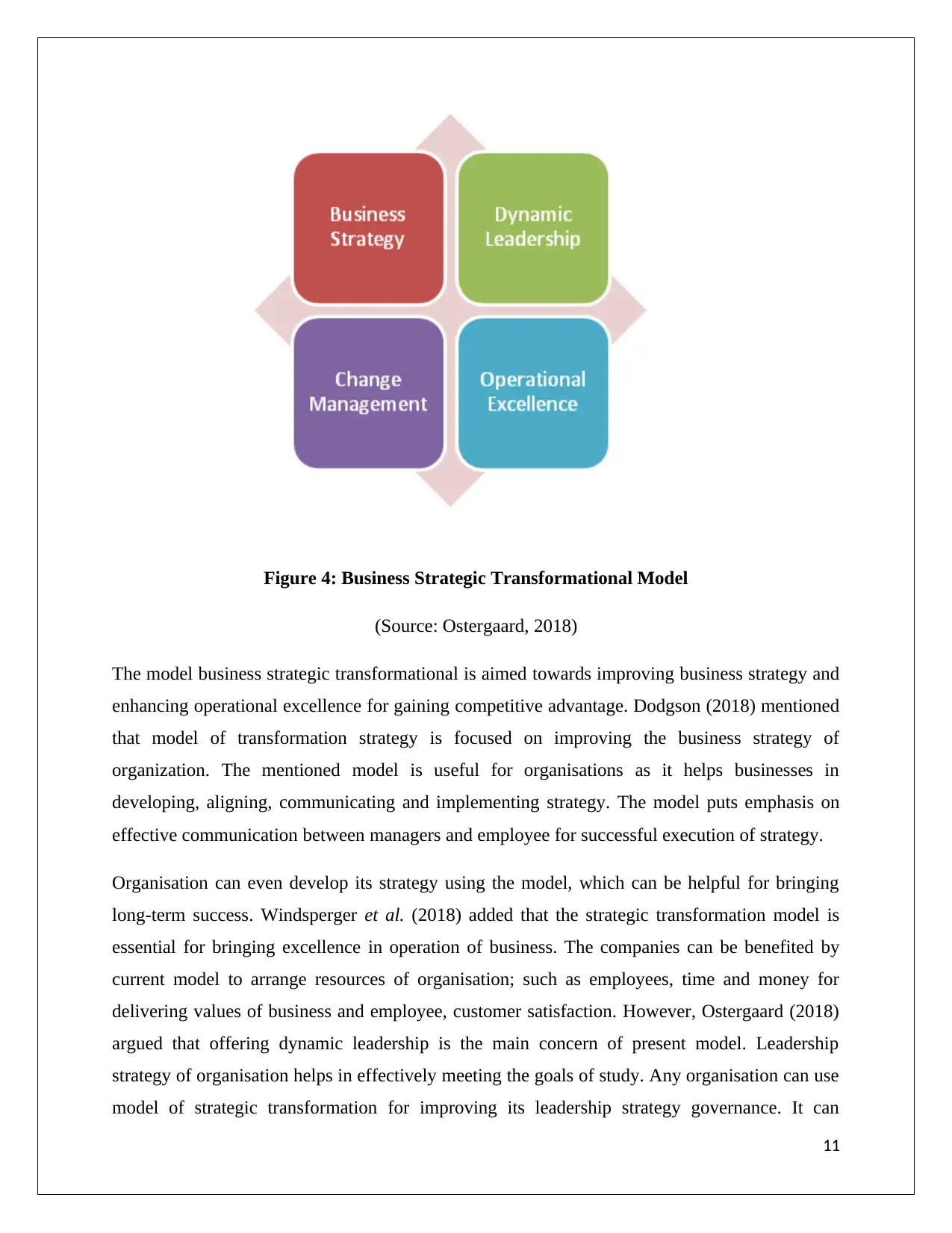
Figure 4: Business Strategic Transformational Model
(Source: Ostergaard, 2018)
The model business strategic transformational is aimed towards improving business strategy and
enhancing operational excellence for gaining competitive advantage. Dodgson (2018) mentioned
that model of transformation strategy is focused on improving the business strategy of
organization. The mentioned model is useful for organisations as it helps businesses in
developing, aligning, communicating and implementing strategy. The model puts emphasis on
effective communication between managers and employee for successful execution of strategy.
Organisation can even develop its strategy using the model, which can be helpful for bringing
long-term success. Windsperger et al. (2018) added that the strategic transformation model is
essential for bringing excellence in operation of business. The companies can be benefited by
current model to arrange resources of organisation; such as employees, time and money for
delivering values of business and employee, customer satisfaction. However, Ostergaard (2018)
argued that offering dynamic leadership is the main concern of present model. Leadership
strategy of organisation helps in effectively meeting the goals of study. Any organisation can use
model of strategic transformation for improving its leadership strategy governance. It can
11
(Source: Ostergaard, 2018)
The model business strategic transformational is aimed towards improving business strategy and
enhancing operational excellence for gaining competitive advantage. Dodgson (2018) mentioned
that model of transformation strategy is focused on improving the business strategy of
organization. The mentioned model is useful for organisations as it helps businesses in
developing, aligning, communicating and implementing strategy. The model puts emphasis on
effective communication between managers and employee for successful execution of strategy.
Organisation can even develop its strategy using the model, which can be helpful for bringing
long-term success. Windsperger et al. (2018) added that the strategic transformation model is
essential for bringing excellence in operation of business. The companies can be benefited by
current model to arrange resources of organisation; such as employees, time and money for
delivering values of business and employee, customer satisfaction. However, Ostergaard (2018)
argued that offering dynamic leadership is the main concern of present model. Leadership
strategy of organisation helps in effectively meeting the goals of study. Any organisation can use
model of strategic transformation for improving its leadership strategy governance. It can
11
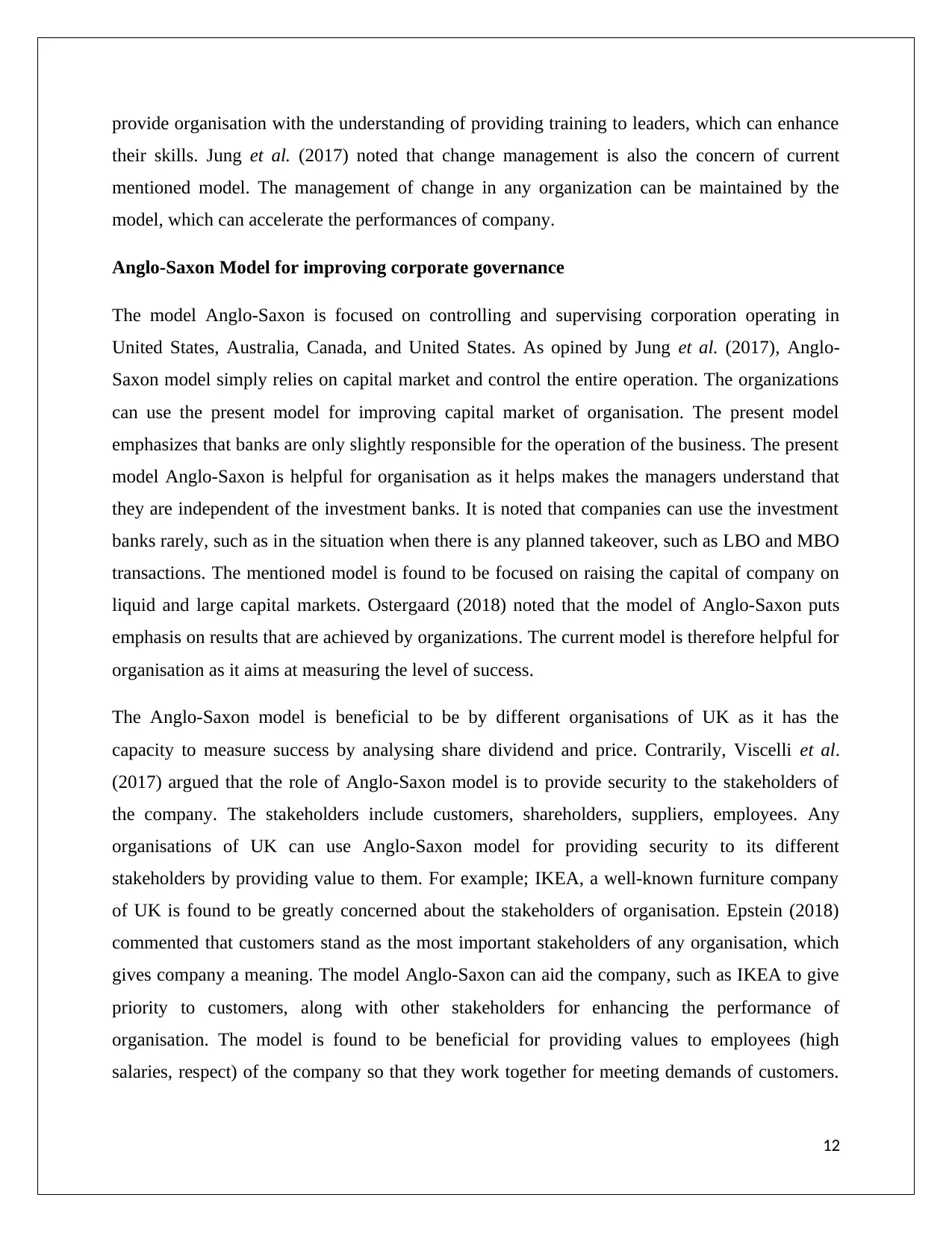
provide organisation with the understanding of providing training to leaders, which can enhance
their skills. Jung et al. (2017) noted that change management is also the concern of current
mentioned model. The management of change in any organization can be maintained by the
model, which can accelerate the performances of company.
Anglo-Saxon Model for improving corporate governance
The model Anglo-Saxon is focused on controlling and supervising corporation operating in
United States, Australia, Canada, and United States. As opined by Jung et al. (2017), Anglo-
Saxon model simply relies on capital market and control the entire operation. The organizations
can use the present model for improving capital market of organisation. The present model
emphasizes that banks are only slightly responsible for the operation of the business. The present
model Anglo-Saxon is helpful for organisation as it helps makes the managers understand that
they are independent of the investment banks. It is noted that companies can use the investment
banks rarely, such as in the situation when there is any planned takeover, such as LBO and MBO
transactions. The mentioned model is found to be focused on raising the capital of company on
liquid and large capital markets. Ostergaard (2018) noted that the model of Anglo-Saxon puts
emphasis on results that are achieved by organizations. The current model is therefore helpful for
organisation as it aims at measuring the level of success.
The Anglo-Saxon model is beneficial to be by different organisations of UK as it has the
capacity to measure success by analysing share dividend and price. Contrarily, Viscelli et al.
(2017) argued that the role of Anglo-Saxon model is to provide security to the stakeholders of
the company. The stakeholders include customers, shareholders, suppliers, employees. Any
organisations of UK can use Anglo-Saxon model for providing security to its different
stakeholders by providing value to them. For example; IKEA, a well-known furniture company
of UK is found to be greatly concerned about the stakeholders of organisation. Epstein (2018)
commented that customers stand as the most important stakeholders of any organisation, which
gives company a meaning. The model Anglo-Saxon can aid the company, such as IKEA to give
priority to customers, along with other stakeholders for enhancing the performance of
organisation. The model is found to be beneficial for providing values to employees (high
salaries, respect) of the company so that they work together for meeting demands of customers.
12
their skills. Jung et al. (2017) noted that change management is also the concern of current
mentioned model. The management of change in any organization can be maintained by the
model, which can accelerate the performances of company.
Anglo-Saxon Model for improving corporate governance
The model Anglo-Saxon is focused on controlling and supervising corporation operating in
United States, Australia, Canada, and United States. As opined by Jung et al. (2017), Anglo-
Saxon model simply relies on capital market and control the entire operation. The organizations
can use the present model for improving capital market of organisation. The present model
emphasizes that banks are only slightly responsible for the operation of the business. The present
model Anglo-Saxon is helpful for organisation as it helps makes the managers understand that
they are independent of the investment banks. It is noted that companies can use the investment
banks rarely, such as in the situation when there is any planned takeover, such as LBO and MBO
transactions. The mentioned model is found to be focused on raising the capital of company on
liquid and large capital markets. Ostergaard (2018) noted that the model of Anglo-Saxon puts
emphasis on results that are achieved by organizations. The current model is therefore helpful for
organisation as it aims at measuring the level of success.
The Anglo-Saxon model is beneficial to be by different organisations of UK as it has the
capacity to measure success by analysing share dividend and price. Contrarily, Viscelli et al.
(2017) argued that the role of Anglo-Saxon model is to provide security to the stakeholders of
the company. The stakeholders include customers, shareholders, suppliers, employees. Any
organisations of UK can use Anglo-Saxon model for providing security to its different
stakeholders by providing value to them. For example; IKEA, a well-known furniture company
of UK is found to be greatly concerned about the stakeholders of organisation. Epstein (2018)
commented that customers stand as the most important stakeholders of any organisation, which
gives company a meaning. The model Anglo-Saxon can aid the company, such as IKEA to give
priority to customers, along with other stakeholders for enhancing the performance of
organisation. The model is found to be beneficial for providing values to employees (high
salaries, respect) of the company so that they work together for meeting demands of customers.
12
⊘ This is a preview!⊘
Do you want full access?
Subscribe today to unlock all pages.

Trusted by 1+ million students worldwide
1 out of 37
Related Documents
Your All-in-One AI-Powered Toolkit for Academic Success.
+13062052269
info@desklib.com
Available 24*7 on WhatsApp / Email
![[object Object]](/_next/static/media/star-bottom.7253800d.svg)
Unlock your academic potential
Copyright © 2020–2025 A2Z Services. All Rights Reserved. Developed and managed by ZUCOL.





